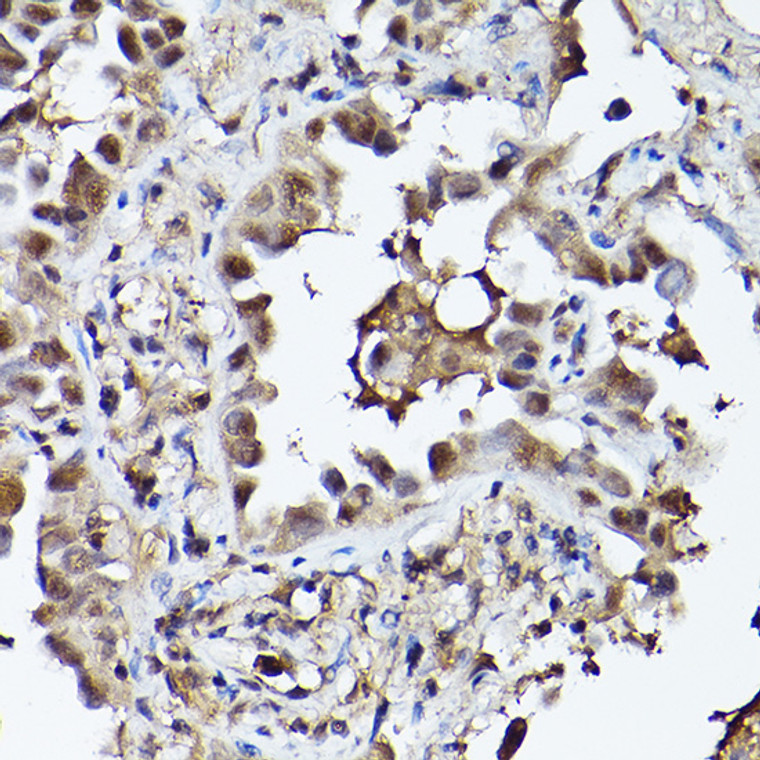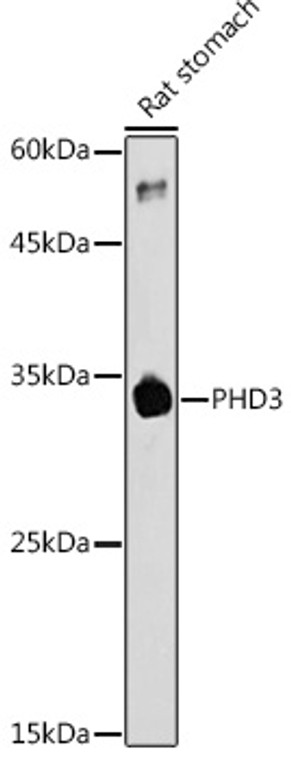| Host: |
Rabbit |
| Applications: |
WB/IHC/IF |
| Reactivity: |
Human/Mouse/Rat |
| Note: |
STRICTLY FOR FURTHER SCIENTIFIC RESEARCH USE ONLY (RUO). MUST NOT TO BE USED IN DIAGNOSTIC OR THERAPEUTIC APPLICATIONS. |
| Short Description: |
Rabbit polyclonal antibody anti-PHD3 (1-100) is suitable for use in Western Blot, Immunohistochemistry and Immunofluorescence research applications. |
| Clonality: |
Polyclonal |
| Conjugation: |
Unconjugated |
| Isotype: |
IgG |
| Formulation: |
PBS with 0.05% Proclin300, 50% Glycerol, pH7.3. |
| Purification: |
Affinity purification |
| Dilution Range: |
WB 1:500-1:1000IHC-P 1:50-1:200IF/ICC 1:50-1:200 |
| Storage Instruction: |
Store at-20°C for up to 1 year from the date of receipt, and avoid repeat freeze-thaw cycles. |
| Gene Symbol: |
EGLN3 |
| Gene ID: |
112399 |
| Uniprot ID: |
EGLN3_HUMAN |
| Immunogen Region: |
1-100 |
| Immunogen: |
A synthetic peptide corresponding to a sequence within amino acids 1-100 of human PHD3 (NP_071356.1). |
| Immunogen Sequence: |
MPLGHIMRLDLEKIALEYIV PCLHEVGFCYLDNFLGEVVG DCVLERVKQLHCTGALRDGQ LAGPRAGVSKRHLRGDQITW IGGNEEGCEAISFLLSLIDR |
| Tissue Specificity | Widely expressed at low levels. Expressed at higher levels in adult heart (cardiac myocytes, aortic endothelial cells and coronary artery smooth muscle), lung and placenta, and in fetal spleen, heart and skeletal muscle. Also expressed in pancreas. Localized to pancreatic acini and islet cells. |
| Post Translational Modifications | Ubiquitinated by SIAH1 and/or SIAH2 in response to the unfolded protein response (UPR), leading to its degradation. |
| Function | Prolyl hydroxylase that mediates hydroxylation of proline residues in target proteins, such as PKM, TELO2, ATF4 and HIF1A. Target proteins are preferentially recognized via a LXXLAP motif. Cellular oxygen sensor that catalyzes, under normoxic conditions, the post-translational formation of 4-hydroxyproline in hypoxia-inducible factor (HIF) alpha proteins. Hydroxylates a specific proline found in each of the oxygen-dependent degradation (ODD) domains (N-terminal, NODD, and C-terminal, CODD) of HIF1A. Also hydroxylates HIF2A. Has a preference for the CODD site for both HIF1A and HIF2A. Hydroxylation on the NODD site by EGLN3 appears to require prior hydroxylation on the CODD site. Hydroxylated HIFs are then targeted for proteasomal degradation via the von Hippel-Lindau ubiquitination complex. Under hypoxic conditions, the hydroxylation reaction is attenuated allowing HIFs to escape degradation resulting in their translocation to the nucleus, heterodimerization with HIF1B, and increased expression of hypoxy-inducible genes. ELGN3 is the most important isozyme in limiting physiological activation of HIFs (particularly HIF2A) in hypoxia. Also hydroxylates PKM in hypoxia, limiting glycolysis. Under normoxia, hydroxylates and regulates the stability of ADRB2. Regulator of cardiomyocyte and neuronal apoptosis. In cardiomyocytes, inhibits the anti-apoptotic effect of BCL2 by disrupting the BAX-BCL2 complex. In neurons, has a NGF-induced proapoptotic effect, probably through regulating CASP3 activity. Also essential for hypoxic regulation of neutrophilic inflammation. Plays a crucial role in DNA damage response (DDR) by hydroxylating TELO2, promoting its interaction with ATR which is required for activation of the ATR/CHK1/p53 pathway. Also mediates hydroxylation of ATF4, leading to decreased protein stability of ATF4 (Probable). |
| Protein Name | Prolyl Hydroxylase Egln3Egl Nine Homolog 3Hph-1Hypoxia-Inducible Factor Prolyl Hydroxylase 3Hif-Ph3Hif-Prolyl Hydroxylase 3Hph-3Prolyl Hydroxylase Domain-Containing Protein 3Phd3 |
| Database Links | Reactome: R-HSA-1234176 |
| Cellular Localisation | NucleusCytoplasmColocalizes With Wdr83 In The Cytoplasm |
| Alternative Antibody Names | Anti-Prolyl Hydroxylase Egln3 antibodyAnti-Egl Nine Homolog 3 antibodyAnti-Hph-1 antibodyAnti-Hypoxia-Inducible Factor Prolyl Hydroxylase 3 antibodyAnti-Hif-Ph3 antibodyAnti-Hif-Prolyl Hydroxylase 3 antibodyAnti-Hph-3 antibodyAnti-Prolyl Hydroxylase Domain-Containing Protein 3 antibodyAnti-Phd3 antibodyAnti-EGLN3 antibody |
Information sourced from Uniprot.org
12 months for antibodies. 6 months for ELISA Kits. Please see website T&Cs for further guidance

















